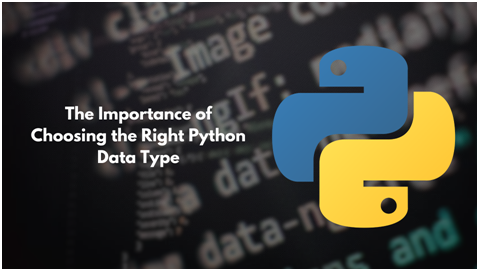If you are a data Wizard or a Python enthusiast, you might wonder why one should bother with Python Data Types when Python is such a flexible language. In programming, creativity has no bounds, the choice of data types might seem like a insignificant matter. As experienced Python programmers will attest, choosing the appropriate data type can have a significant impact on your code’s readability and performance. In this blog, we’ll explore the value of Python Training, which can help you to master Python easily.
Table of contents
- Python Data Types
- Numbers: Integers vs. Floats
- Strings: Choosing Your Words Carefully
- Lists vs. Tuples: Mutable vs. Immutable
- Dictionaries: Key-Value Magic
- Conclusion
Python Data Types
- Let’s talk about the “why” of choosing the right data type before we go into the “how.” You can see that Python, which is well known for its simplicity and versatility, can be used to work with a variety of data types. Selecting the right data type is necessary to write efficient, error-free code is very important. Here’s why it matters:
- Different types of data demand varying quantities of RAM and computing power. Selecting the right type can greatly improve the performance of your code.
- Selecting the appropriate data type guarantees accurate data manipulation and storage. It stops unanticipated mistakes or outcomes.
- Code is helpful for people as well as machines! Code that uses the suitable data types is easier to read and maintain.
- Python has an abundance of frameworks and libraries. Compatibility with these resources is ensured by using the appropriate data types.
Now that you understand the importance of it let’s look at how to choose wisely.
Numbers: Integers vs. Floats
Let’s begin with the fundamentals: figures. Two main numeric data types are available in Python: integers and floats. Floats are numbers with decimal points (e.g., 3.14, -0.005), whereas integers are whole numbers (e.g., 5, -10).
When to use integers:
- When counting objects, for example, you need exact whole numbers.
- For computations where performance is crucial (integers are faster).
When to use floats:
- When working with decimal measures or values (such as currency or temperature).
- With scientific computers or in any field where accuracy is essential.
Strings: Choosing Your Words Carefully
Python uses strings to represent text. Although they are very flexible, choosing the correct string type might improve the efficiency of your code.
- Double Quotes (“”) vs. Single Quotes (‘ ‘): In Python, strings can be defined using either double or single quotes. Although it’s a question of taste, regularity is essential.
- Raw Strings (r’ ‘): Using plain strings when working with file paths or regular expressions. They stop the treatment of backslashes() as escape characters.
- F-Strings (f” “): These are the best string format options. For dynamic content, they let you embed expressions inside string literals.
- Choosing Between String Types: Python provides several string types, including bytes, str, and byte arrays. Select the option that is consistent with your data. Use str for text and bytes or byte array for binary data.
Lists vs. Tuples: Mutable vs. Immutable
Collections of elements can be stored in lists or tuples. The essential distinction? Tuples are immutable (cannot be modified once generated), whereas lists are mutable (may be changed).
When to use lists:
- When you require an assemblage of elastic elements (e.g., elements added or removed).
- For varying-length sequences.
When to use tuples:
- When you wish to guard against unintentional alterations and guarantee data integrity.
- For sequences (like coordinates or RGB values) with a set number of elements.
Dictionaries: Key-Value Magic
Python’s key-value data format dictionaries provide quick and easy value lookup and retrieval. When picking out your dictionary’s keys:
- Immutability: Immutable data types, such as strings, integers, and tuples, should be used for keys. Dictionary entries and lists can be modified and not used as keys.
- Uniqueness: Within a dictionary, keys ought to be distinct. Data loss may result from duplicate keys.
- Hashability: Immutable types are hashable, making them suitable for dictionary keys. This feature makes lookups efficient.
Conclusion
It’s a tiny step that can tremendously impact your experiences learning to code. Among Python’s many advantages are its versatility and large number of data types. But enormous power also entails immense responsibility! Selecting the appropriate Python data type is crucial and cannot be emphasised enough. It affects your code’s readability, performance, and—above all—reliability.




